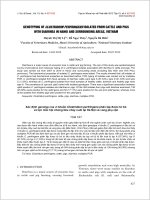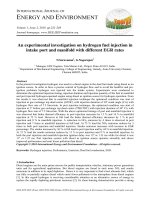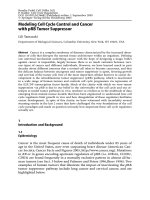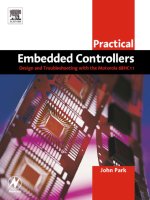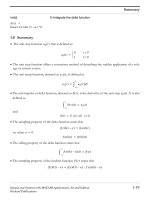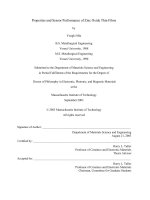- Trang chủ >>
- Khoa Học Tự Nhiên >>
- Vật lý
engineering thin films and nanostructures with ion beams, 2005, p.561
Bạn đang xem bản rút gọn của tài liệu. Xem và tải ngay bản đầy đủ của tài liệu tại đây (29.82 MB, 561 trang )
DK2964_half 2/23/05 11:17 AM Page 1
Engineering Thin Films
and Nanostructures
with Ion Beams
© 2005 by Taylor & Francis Group, LLC
DK2964_series.qxd
3/4/05
11:23 AM
Page 1
OPTICAL ENGINEERING
Founding Editor
Brian J. Thompson
University of Rochester
Rochester, New York
1.
2.
3.
4.
5.
6.
7.
8.
9.
10.
11.
12.
13.
14.
15.
16.
17.
18.
Electron and Ion Microscopy and Microanalysis: Principles
and Applications, Lawrence E. Murr
Acousto-Optic Signal Processing: Theory
and Implementation, edited by Nor man J. Berg
and John N. Lee
Electro-Optic and Acousto-Optic Scanning and Deflection,
Milton Gottlieb, Clive L. M. Ireland, and John Martin Ley
Single-Mode Fiber Optics: Principles and Applications,
Luc B. Jeunhomme
Pulse Code Formats for Fiber Optical Data
Communication: Basic Principles and Applications,
David J. Morris
Optical Materials: An Introduction to Selection
and Application, Solomon Musikant
Infrared Methods for Gaseous Measurements: Theory
and Practice, edited by Joda Wormhoudt
Laser Beam Scanning: Opto-Mechanical Devices,
Systems, and Data Storage Optics, edited by
Gerald F. Marshall
Opto-Mechanical Systems Design, Paul R. Yoder, Jr.
Optical Fiber Splices and Connectors: Theory
and Methods, Calvin M. Miller with Stephen C. Mettler
and Ian A. White
Laser Spectroscopy and Its Applications, edited by
Leon J. Radziemski, Richard W. Solarz,
and Jeffrey A. Paisner
Infrared Optoelectronics: Devices and Applications,
William Nunley and J. Scott Bechtel
Integrated Optical Circuits and Components: Design
and Applications, edited by Lynn D. Hutcheson
Handbook of Molecular Lasers, edited by Peter K. Cheo
Handbook of Optical Fibers and Cables, Hiroshi Murata
Acousto-Optics, Adrian Korpel
Procedures in Applied Optics, John Strong
Handbook of Solid-State Lasers, edited by Peter K. Cheo
© 2005 by Taylor & Francis Group, LLC
DK2964_series.qxd
3/4/05
11:23 AM
Page 2
19. Optical Computing: Digital and Symbolic, edited by
Raymond Arrathoon
20. Laser Applications in Physical Chemistry, edited by
D. K. Evans
21. Laser-Induced Plasmas and Applications, edited by
Leon J. Radziemski and David A. Cremers
22. Infrared Technology Fundamentals, Irving J. Spiro
and Monroe Schlessinger
23. Single-Mode Fiber Optics: Principles and Applications,
Second Edition, Revised and Expanded,
Luc B. Jeunhomme
24. Image Analysis Applications, edited by Rangachar Kasturi
and Mohan M. Trivedi
25. Photoconductivity: Art, Science, and Technology,
N. V. Joshi
26. Principles of Optical Circuit Engineering, Mark A. Mentzer
27. Lens Design, Milton Laikin
28. Optical Components, Systems, and Measurement
Techniques, Rajpal S. Sirohi and M. P. Kothiyal
29. Electron and Ion Microscopy and Microanalysis:
Principles and Applications, Second Edition, Revised
and Expanded, Lawrence E. Murr
30. Handbook of Infrared Optical Materials, edited by
Paul Klocek
31. Optical Scanning, edited by Gerald F. Marshall
32. Polymers for Lightwave and Integrated Optics:
Technology and Applications, edited by
Lawrence A. Hornak
33. Electro-Optical Displays, edited by Mohammad A. Karim
34. Mathematical Morphology in Image Processing,
edited by Edward R. Dougherty
35. Opto-Mechanical Systems Design: Second Edition,
Revised and Expanded, Paul R. Yoder, Jr.
36. Polarized Light: Fundamentals and Applications,
Edward Collett
37. Rare Earth Doped Fiber Lasers and Amplifiers,
edited by Michel J. F. Digonnet
38. Speckle Metrology, edited by Rajpal S. Sirohi
39. Organic Photoreceptors for Imaging Systems,
Paul M. Borsenberger and David S. Weiss
40. Photonic Switching and Interconnects, edited by
Abdellatif Marrakchi
41. Design and Fabrication of Acousto-Optic Devices,
edited by Akis P. Goutzoulis and Dennis R. Pape
© 2005 by Taylor & Francis Group, LLC
DK2964_series.qxd
3/4/05
11:23 AM
Page 3
42. Digital Image Processing Methods, edited by
Edward R. Dougherty
43. Visual Science and Engineering: Models and Applications,
edited by D. H. Kelly
44. Handbook of Lens Design, Daniel Malacara
and Zacarias Malacara
45. Photonic Devices and Systems, edited by
Robert G. Hunsberger
46. Infrared Technology Fundamentals: Second Edition,
Revised and Expanded, edited by Monroe Schlessinger
47. Spatial Light Modulator Technology: Materials, Devices,
and Applications, edited by Uzi Efron
48. Lens Design: Second Edition, Revised and Expanded,
Milton Laikin
49. Thin Films for Optical Systems, edited by
Francoise R. Flory
50. Tunable Laser Applications, edited by F. J. Duarte
51. Acousto-Optic Signal Processing: Theory and
Implementation, Second Edition, edited by
Norman J. Berg and John M. Pellegrino
52. Handbook of Nonlinear Optics, Richard L. Sutherland
53. Handbook of Optical Fibers and Cables: Second Edition,
Hiroshi Murata
54. Optical Storage and Retrieval: Memory, Neural Networks,
and Fractals, edited by Francis T. S. Yu
and Suganda Jutamulia
55. Devices for Optoelectronics, Wallace B. Leigh
56. Practical Design and Production of Optical Thin Films,
Ronald R. Willey
57. Acousto-Optics: Second Edition, Adrian Korpel
58. Diffraction Gratings and Applications, Erwin G. Loewen
and Evgeny Popov
59. Organic Photoreceptors for Xerography,
Paul M. Borsenberger and David S. Weiss
60. Characterization Techniques and Tabulations for Organic
Nonlinear Optical Materials, edited by Mark G. Kuzyk
and Carl W. Dirk
61. Interferogram Analysis for Optical Testing,
Daniel Malacara, Manuel Servin, and Zacarias Malacara
62. Computational Modeling of Vision: The Role of
Combination, William R. Uttal, Ramakrishna Kakarala,
Spiram Dayanand, Thomas Shepherd, Jagadeesh Kalki,
Charles F. Lunskis, Jr., and Ning Liu
© 2005 by Taylor & Francis Group, LLC
DK2964_series.qxd
3/4/05
11:23 AM
Page 4
63. Microoptics Technology: Fabrication and Applications of
Lens Arrays and Devices, Nicholas Borrelli
64. Visual Information Representation, Communication, and
Image Processing, edited by Chang Wen Chen
and Ya-Qin Zhang
65. Optical Methods of Measurement, Rajpal S. Sirohi
and F. S. Chau
66. Integrated Optical Circuits and Components: Design
and Applications, edited by Edmond J. Murphy
67. Adaptive Optics Engineering Handbook, edited by
Robert K. Tyson
68. Entropy and Information Optics, Francis T. S. Yu
69. Computational Methods for Electromagnetic and Optical
Systems, John M. Jarem and Partha P. Banerjee
70. Laser Beam Shaping, Fred M. Dickey
and Scott C. Holswade
71. Rare-Earth-Doped Fiber Lasers and Amplifiers: Second
Edition, Revised and Expanded, edited by
Michel J. F. Digonnet
72. Lens Design: Third Edition, Revised and Expanded,
Milton Laikin
73. Handbook of Optical Engineering, edited by
Daniel Malacara and Brian J. Thompson
74. Handbook of Imaging Materials: Second Edition, Revised
and Expanded, edited by Arthur S. Diamond
and David S. Weiss
75. Handbook of Image Quality: Characterization and
Prediction, Brian W. Keelan
76. Fiber Optic Sensors, edited by Francis T. S. Yu
and Shizhuo Yin
77. Optical Switching/Networking and Computing for
Multimedia Systems, edited by Mohsen Guizani
and Abdella Battou
78. Image Recognition and Classification: Algorithms,
Systems, and Applications, edited by Bahram Javidi
79. Practical Design and Production of Optical Thin Films:
Second Edition, Revised and Expanded, Ronald R. Willey
80. Ultrafast Lasers: Technology and Applications,
edited by Martin E. Fermann, Almantas Galvanauskas,
and Gregg Sucha
81. Light Propagation in Periodic Media: Differential Theory
and Design, Michel Nevière and Evgeny Popov
82. Handbook of Nonlinear Optics, Second Edition, Revised
and Expanded, Richard L. Sutherland
© 2005 by Taylor & Francis Group, LLC
DK2964_series.qxd
3/4/05
11:23 AM
Page 5
83. Polarized Light: Second Edition, Revised and Expanded,
Dennis Goldstein
84. Optical Remote Sensing: Science and Technology,
Walter Egan
85. Handbook of Optical Design: Second Edition,
Daniel Malacara and Zacarias Malacara
86. Nonlinear Optics: Theory, Numerical Modeling, and
Applications, Partha P. Banerjee
87. Semiconductor and Metal Nanocrystals: Synthesis and
Electronic and Optical Properties, edited by
Victor I. Klimov
88. High-Performance Backbone Network Technology,
edited by Naoaki Yamanaka
89. Semiconductor Laser Fundamentals, Toshiaki Suhara
90. Handbook of Optical and Laser Scanning, edited by
Gerald F. Marshall
91. Organic Light-Emitting Diodes: Principles, Characteristics,
and Processes, Jan Kalinowski
92. Micro-Optomechatronics, Hiroshi Hosaka,
Yoshitada Katagiri, Terunao Hirota, and Kiyoshi Itao
93. Microoptics Technology: Second Edition,
Nicholas F. Borrelli
94. Engineering Thin Films and Nanostructures with Ion
Beams, edited by Émile Knystautas
95. Interferogram Analysis for Optical Testing, Second Edition,
Daniel Malacara, Manuel Sercin, and Zacarias Malacara
96. Laser Remote Sensing, Takashi Fujii and Tetsuo Fukuchi
97. Passive Micro-Optical Alignment Methods,
Robert A. Boudreau and Sharon M. Doudreau
98. Organic Photovoltaics: Mechanism, Materials,
and Devices, edited by Sam-Shajing Sun
and Niyazi Serdar Saracftci
© 2005 by Taylor & Francis Group, LLC
DK2964_title 3/4/05 11:20 AM Page 1
Engineering Thin Films
and Nanostructures
with Ion Beams
edited by
Émile Knystautas
Boca Raton London New York Singapore
A CRC title, part of the Taylor & Francis imprint, a member of the
Taylor & Francis Group, the academic division of T&F Informa plc.
© 2005 by Taylor & Francis Group, LLC
DK2964 discl Page 1 Wednesday, March 2, 2005 1:08 PM
Published in 2005 by
CRC Press
Taylor & Francis Group
6000 Broken Sound Parkway NW, Suite 300
Boca Raton, FL 33487-2742
© 2005 by Taylor & Francis Group, LLC
CRC Press is an imprint of Taylor & Francis Group
No claim to original U.S. Government works
Printed in the United States of America on acid-free paper
10 9 8 7 6 5 4 3 2 1
International Standard Book Number-10: 0-8247-2447-X (Hardcover)
International Standard Book Number-13: 978-0-8247-2447-4 (Hardcover)
Library of Congress Card Number 2004058212
This book contains information obtained from authentic and highly regarded sources. Reprinted material is
quoted with permission, and sources are indicated. A wide variety of references are listed. Reasonable efforts
have been made to publish reliable data and information, but the author and the publisher cannot assume
responsibility for the validity of all materials or for the consequences of their use.
No part of this book may be reprinted, reproduced, transmitted, or utilized in any form by any electronic,
mechanical, or other means, now known or hereafter invented, including photocopying, microfilming, and
recording, or in any information storage or retrieval system, without written permission from the publishers.
For permission to photocopy or use material electronically from this work, please access www.copyright.com
( or contact the Copyright Clearance Center, Inc. (CCC) 222 Rosewood Drive,
Danvers, MA 01923, 978-750-8400. CCC is a not-for-profit organization that provides licenses and registration
for a variety of users. For organizations that have been granted a photocopy license by the CCC, a separate
system of payment has been arranged.
Trademark Notice: Product or corporate names may be trademarks or registered trademarks, and are used only
for identification and explanation without intent to infringe.
Library of Congress Cataloging-in-Publication Data
Engineering thin films and nonostructures with ion beams / [edited by] Emile Knystautas.
p. cm. -- (Optical engineering ; 92)
Includes bibliographical references and index.
ISBN 0-8247-2447-X (alk. paper)
1. Thin films. 2. Nanostructures. 3. Ion bombardment--Industrial applications. I. Knystautas,
Emile J. II. Optical engineering (Marcel Dekker, Inc.) ; v. 92.
TA418.9.T45E52 2004
621.3815'2--dc22
2004058212
Visit the Taylor & Francis Web site at
Taylor & Francis Group
is the Academic Division of T&F Informa plc.
© 2005 by Taylor & Francis Group, LLC
and the CRC Press Web site at
DK2964_C000.fm Page vii Monday, March 7, 2005 11:00 AM
Preface
In the last two decades, many books have been published on
ion implantation and ion-beam processing. Why this one now?
After all, the advantages of using an energetic ion beam to
modify surfaces with a view to enhancing their tribological,
electrochemical, optical and magnetic properties have been
known for some time.
The aim of this volume is to review the basics of previous
work on ion-beam modification of materials and to include
enough new material on novel applications to bring newcomers “up to speed” in this exciting area. The authors are all
recognized researchers in their respective areas, and the
reader will surely benefit from exposure to their expertise.
We present a mix of fundamental aspects in addition to very
practical topics as they relate to industrial uses of these techniques.
While it used to be that ion-beam-based processes related
mainly to simply doping of the “near surface,” more recent
research centers on the customized (hence the word “engineering” in the title) creation of structures on a fine, i.e.,
© 2005 by Taylor & Francis Group, LLC
DK2964_C000.fm Page viii Monday, March 7, 2005 11:00 AM
nanometer, scale. Ion beams are now used to aggregate metals
and semiconductors into nanoclusters with nonlinear optical
properties, to make nanopores of varying dimensions in polymer film alloys and superconductors and to fabricate nanopillars, “nanoflowers” and interconnected nanochannels in
three dimensions by the use of sophisticated atomic shadowing techniques, to name just a few.
A Glossary is included at the end of the volume for the
benefit of those who may be new to this area and unfamiliar
with some of the terms and acronyms used herein. Included
in a CD accompanying this volume are video clips taken in
an electron microscope that provide striking visual evidence
of crater formation and annealing by ion beams.
It is a pleasure to thank all authors for their efforts and
professionalism in presenting their contributions.
Émile Knystautas
Québec, Québec
March 2004
© 2005 by Taylor & Francis Group, LLC
DK2964_C000.fm Page ix Monday, March 7, 2005 11:00 AM
Editor
Émile Knystautas was born in Kempten, Bavaria. He received
his B.Sc. degree in physics from the Université de Montréal,
and M.S. and Ph.D. degrees in physics from the University of
Connecticut. Professeur titulaire at Université Laval during
the preparation of this book, and a firm believer that one
should change jobs every 35 years, he has recently taken up
a new position as scientific director of a new nanotechnology
center, CIVEN (Coordinamento Interuniversitario Veneto per
le Nanotecnologie) in Venice, Italy. From 1978 to 1979, he was
a guest worker and consultant at the Atomic and Plasma
Radiation Division of the National Bureau of Standards (now
N.I.S.T.). Although most of his career has been devoted to
fundamental atomic physics studies, especially concerning
rather exotic excited states in highly charged ions, his more
recent activities also deal with the creation, modification, and
characterization of novel materials using ion irradiation.
Recent projects have included producing quasicrystals and
shape-memory alloys in thin films, making multilayer mirrors
for soft x-rays, high-voltage poling of silica for second-harmonic generation, the production of nonlinear optical effects
in chalcogenide and other glasses using ion-beam methods,
and the use of liquid-crystal-filled nanopores in polymer films
in potential photonics applications.
© 2005 by Taylor & Francis Group, LLC
DK2964_C000.fm Page xi Monday, March 7, 2005 11:00 AM
Contributors
John E.E. Baglin
IBM Almaden Research
Center
San Jose, California
Robert C. Birtcher
Materials Science Division
Argonne National
Laboratory
S.E. Donnelly
Joule Physics Laboratory
Faculty of Science,
Engineering and
Environment
University of Salford
Manchester, U.K.
David B. Fenner
Epion Corporation
Argonne, Illinois
Billerica, Massachusetts
J.D. Demaree
U.S. Army Research Lab
Aberdeen, Maryland
and
Research Professor
Department of Electrical and
Computer Engineering
Boston University
E. Cattaruzza
INFM Department of Physical
Chemistry
University of Venice
Venice, Italy
© 2005 by Taylor & Francis Group, LLC
Boston, Massachusetts
Robert L. Fleischer
Department of Geology
Union College
Schenectady, New York
DK2964_C000.fm Page xii Monday, March 7, 2005 11:00 AM
Daniel Gall
Department of Material
Sciences and Engineering
Rensselaer Polytechnic
Institute
Materials Science and
Technology Division
Los Alamos National
Laboratory
Troy, New York
Los Alamos, New Mexico
F. Gonella
INFM Department of Physical
Chemistry
Michael Nastasi
Materials Science and
Technology Division
Los Alamos National
Laboratory
University of Venice
Venice, Italy
A. Misra
James K. Hirvonen
U.S. Army Research Lab
Los Alamos, New Mexico
Aberdeen, Maryland
K. Nordlund
Accelerator Laboratory
University of Helsinki
Charles H. Koch
Institute of Materials
Science
University of Connecticut
Storrs, Connecticut
G. Mattei
INFM Department of Physics
University of Padova
Padova, Italy
Koji Matsuda
Nissin Ion Equipment
Company
Kyoto, Japan
C. Maurizio
INFM Department of Physics
University of Padova
Padova, Italy
Paolo Mazzoldi
INFM Department of Physics
University of Padova
Padova, Italy
© 2005 by Taylor & Francis Group, LLC
Helsinki, Finland
P.J.T. Nunn
School of Engineering and
Information Technology
University of Sussex
Brighton, U.K.
Masayasu Tanjyo
Nissin Ion Equipment Company
Kyoto, Japan
P.D. Townsend
School of Engineering and
Information Technology
University of Sussex
Brighton, U.K.
DK2964_book.fm Page xiii Wednesday, March 2, 2005 1:03 PM
Contents
Chapter 1
Introduction
Chapter 2
Single Ion Induced Spike Effects on Thin Metal Films:
Observation and Simulation
S.E. Donnelly, R.C. Birtcher, and K. Nordlund
Chapter 3 9 Ion Beam Effects in Magnetic Thin Films
John E.E. Baglin
Chapter 4
Selected Topics in Ion Beam Surface
Engineering
D.B. Fenner, J.K. Hirvonen, and J.D. Demaree
Chapter 5
Optical Effects of Ion Implantation
P.D. Townsend and P.J.T. Nunn
© 2005 by Taylor & Francis Group, LLC
DK2964_book.fm Page xiv Wednesday, March 2, 2005 1:03 PM
Chapter 6
Metal Alloy Nanoclusters by Ion Implantation in
Silica
P. Mazzoldi, G. Mattei, C. Maurizio, E. Cattaruzza, and F. Gonella
Chapter 7
Intrinsic Residual Stress Evolution in Thin Films
During Energetic Particle Bombardment
A. Misra and M. Nastasi
Chapter 8
Industrial Aspects of Ion-Implantation Equipment
and Ion Beam Generation
Koji Matsuda and Masayasu Tanjyo
Chapter 9
Nanostructured Transition-Metal Nitride
Layers
Daniel Gall
Chapter 10 Nuclear Tracks and Nanostructures
Robert L. Fleischer
Chapter 11 Forensic Applications of Ion-Beam Mixing and
Surface Spectroscopy of Latent Fingerprints
Charles H. Koch
Glossary
© 2005 by Taylor & Francis Group, LLC
DK2964_book.fm Page 1 Wednesday, March 2, 2005 1:03 PM
Chapter 1
Introduction
Thin films can be produced in many forms and have properties
that can differ significantly from their corresponding bulk
form. They can be prepared by a host of techniques such as
sputtering (single or multiple) layers on a substrate, creating
buried waveguides by ion implantation in an optical material,
or making complex nanostructures by ion irradiation during
vapor deposition.
While ion-beam techniques have been a staple of the
semiconductor industry for several decades, their application
to other areas, for example metal surface treatment, have not
been nearly as successful, generally because of cost considerations. Now, however, with the advent of devices of
ever-smaller dimensions, the use of a directed-energy ion
beam appears bound to find many novel industrial applications in the custom tailoring of new materials and devices.
Such potential applications are too numerous to list here, and
any attempt to make predictions at this point about which
will pan out and which will not will likely turn out to have
completely missed the mark a few years hence.
This book will hopefully provide newcomers to this exciting field with an introduction to its potential and also bring
them up to speed on some of the current research in this area.
© 2005 by Taylor & Francis Group, LLC
DK2964_book.fm Page 2 Wednesday, March 2, 2005 1:03 PM
The first chapter deals with fundamental aspects and
examines in detail the effects of a single ion impinging on a
thin film. Using a unique “crossed beam” apparatus at
Argonne National Laboratory consisting of a powerful transmission electron microscope that views a surface that is bombarded by hundreds of keV heavy ions, Steve Donnelly and
his colleagues have studied the dynamics of crater and hole
formation on metallic surfaces when individual ions impinge
on a surface. Comparison with molecular dynamics simulations have given a satisfyingly complete picture of some of
the basic mechanisms involved in the formation of craters and
their (occasional) annealing by subsequent ion impacts. On
the other hand, there are still other matters, such as the
emission of nanoclusters, which require further study. Visual
evidence of the effects of single-ion impacts is provided in the
compact disc accompanying this volume, which contains some
stunning video clips of the phenomena discussed. It is suggested that the reader watch these while reading the corresponding text. Rarely can one see sequential phenomena
presented so vividly on a microscopic scale.
Magnetic recording is the topic of the following chapter
by IBM Almaden’s John Baglin, who discusses the
ever-increasing demand for higher and higher disk-drive densities and how ion-beam techniques can help to achieve them.
After briefly discussing some fundamental results that show
the relative roles of ionization and collision processes for various ion beams and energies, he shows how ion-beam mixing
(as opposed to ion implantation) can be used in some applications even in an industrial environment, where one might
normally expect such a technique to be prohibitively expensive. He points out that spatial resolution issues can also be
resolved in the application of ion-beam processing to magnetic
storage technology.
For many years one of the standard reference books on
ion implantation was the treatise by Jim Hirvonen [“Ion
Implantation,” J.K. Hirvonen, Ed., vol. 18 of “Treatise on
Materials Science and Technology,” Academic Press, N.Y.,
1980]. In the present volume, with two co-authors, he presents
an updated review of ion implantation, ion-beam mixing and
© 2005 by Taylor & Francis Group, LLC
DK2964_book.fm Page 3 Wednesday, March 2, 2005 1:03 PM
IBAD (ion-beam-assisted deposition), pointing out the
strengths and weaknesses of each, as well as a realistic
assessment of their applicability to a variety of research and
manufacturing applications. In addition, the authors introduce a relatively new technique, GCIB (gas-cluster ion-beam
technology) in whose development they played a major role.
This powerful new tool has many similarities to the older
techniques but also some characteristics that could not have
been guessed by straightforward extension from the older
ones. Many recent applications of GCIB technology are discussed, especially in the context of an industrial environment.
Peter Townsend’s monograph [P.D. Townsend, P.J. Chandler and L. Zhang, “Optical Effects of Ion Implantation,” Cambridge University Press, 1994] on the optical applications of
ion implantation is now 10 years old, and he contributes
herein (along with co-author P.J.T. Nunn) a chapter reviewing
these. In addition to discussing the most recent developments
in the field, as well as their relevance to industrial applications, he shares the results of many of his own innovative
experiments on several aspects of this wide area.
One of the topics mentioned in Townsend and Nunn’s
review, that of the non-linear properties of metallic nanoclusters in glasses, is further expanded by the Padova group led
by Paolo Mazzoldi. Together with their Venetian colleagues
(for centuries Venice has been known for its expertise in
glass), they trace the history of the optical properties of metallic nanoclusters in glasses back to Faraday, who spoke of
metallic inclusions as being responsible for the coloration of
glasses. The most recent approach, as described in their chapter, shows how the use of binary alloy nanoclusters allows one
to tune the optical properties of glasses by varying the relative
composition of such alloys.
The next chapter, by Misra and Nastasi of Los Alamos
National Laboratory, discusses an important aspect of
thin-film preparation by ion bombardment that is all too often
ignored in the literature: the stresses, both tensile and compressive, that can be generated by ion-beam methods, and the
problems to which these can give rise (delamination for
instance). They discuss the origins of such stresses at the
© 2005 by Taylor & Francis Group, LLC
DK2964_book.fm Page 4 Wednesday, March 2, 2005 1:03 PM
atomic defect level and describe how varying ion-beam energy
and dose can modify these to achieve the desired results.
While ion-beam techniques are now standard practice in
the semiconductor industry, the demand for micro-devices of
ever-smaller dimensions will require considerable refinement.
An overview of current problems and their practical solution
is provided in the chapter by Koji Matsuda and Masayasu
Tanjyo, both with the Nissin Ion Equipment Co. Ltd. in Kyoto.
Their discussion centers on the demands of production-line
equipment in an industrial, rather than a pure R&D setting.
Daniel Gall’s chapter focuses on applying ion-beam techniques combined with physical vapor deposition to the eventual creation of complex nanostructures in transition metal
nitrides. He provides examples of how nanopipes can be tailored and how atomic shadowing can create separated columns.
Current and future work with deposition at shallow angles to
the surface opens up the prospect of made-to-measure nanopillars, zigzag-shaped columns and helices, “nanoflowers,” and
interconnected nanochannel arrays, to name just a few. Applications are anticipated in magnetic storage devices, photonics,
opto-electronics and molecular transport, among others.
For many years, Bob Fleischer and his colleagues at
GE–Schenectady have exploited a technique for producing
nanometer-dimensioned pores in polymer films. Ion-beam
irradiation is first used to loosen or break bonds in the polymer along the ion trajectory, then chemical etching preferentially removes atomic-scale material that is found along the
ion tracks in the film. In Chapter 10, he recalls this work and
updates it, discussing the mechanisms by which tracks are
formed, and hence how the dimensions of the ensuing pores
can be controlled. He also discusses track formation in other
materials such as intermetallic compounds and oxide superconductors. Aside from the typical applications of these nanopores as filters, there are many others presented, ranging
from the study of voltage pulses generated by viruses and
sea-urchin sperm to improving the properties of superconductors by creating obstacles to the movement of magnetic flux
lines.
© 2005 by Taylor & Francis Group, LLC
DK2964_book.fm Page 5 Wednesday, March 2, 2005 1:03 PM
The last chapter, by Jim Koch of the University of Connecticut, is a good example of the possibilities of innovation
in this field. His work shows how fingerprints can be made
permanent and hence more reliable as forensic evidence by
recoil-mixing them into the substrate using ion beams. Not
only does the record thus become permanent but the fingerprint (even if only a partial one) can then be subjected to very
sensitive surface-analytical techniques that can identify not
only its shape but also its chemical composition.
A Glossary is included at the end of the book for some
terms that may not be familiar to all, given that the intended
audience for this volume consists of those who are not already
working in this particular field. The definitions provided are
“practical” in nature and not intended to be rigorous, aiming
rather to facilitate a fluid reading of the book without interruptions to consult references.
Finally, a compact disc that contains several video files
to supplement the chapter on single-ion impacts (by Donnelly
et al.) is included at the end of the book.
© 2005 by Taylor & Francis Group, LLC
DK2964_book.fm Page 7 Wednesday, March 2, 2005 1:03 PM
Chapter 2
Single Ion Induced Spike Effects on Thin
Metal Films: Observation and
Simulation
S.E. DONNELLY, R.C. BIRTCHER, AND
K. NORDLUND
CONTENTS
Abstract
2.1 Introduction
2.2 Crater and Hole Formation
2.2.1 Ex Situ Studies of Crater Formation
2.2.2 In Situ Studies of Crater Formation
2.2.2.1 Gold
2.2.2.2 Silver
2.2.2.3 Lead
2.2.2.4 Indium
2.2.3 Crater Annihilation
2.2.4 In Situ Studies of Hole Formation
2.2.5 Craters and Holes — Discussion
2.2.4.1 Crater and Hole Annihilation —
Discussion
© 2005 by Taylor & Francis Group, LLC
DK2964_book.fm Page 8 Wednesday, March 2, 2005 1:03 PM
2.3
Nanocluster Emission
2.3.1 Craters and Nanoparticles
2.3.2 Nanoparticle Collection
2.3.3 Radiation Effects on Nanoparticles
2.3.4 Nanoparticle Ejection Rates
2.3.5 Relationship of Nanoparticle Ejection to
Cratering and Cascade Events
2.3.6 Nanoparticle Ejection Mechanisms
2.3.7 Ejected Nanoparticle Size Distribution
2.3.8 Shock Wave Model
2.3.9 Relationship of Nanoparticle Ejection to
Sputtering
2.3.10 Synthesis
2.3.11 Summary of Nanoparticle Experiments
2.4. MD Molecular Dynamics Simulations of Crater
Production
2.4.1 Monte Carlo Simulations versus Molecular
Dynamics
2.4.2 Channeling Effects
2.4.3 MD Simulation Method
2.4.4 Formation of Ordinary Craters
2.4.4.1 Surface Damage Mechanisms
2.4.4.2 Basic Crater Formation Mechanism
2.4.5 Formation of Exotic Crater Structures
2.4.6 Analysis Based on MD
2.4.7 Observations of Nanocluster Ejection
2.5 Conclusions
Acknowledgments
References
ABSTRACT
The combination of in situ electron microscopy with molecular
dynamics (MD) simulations gives important insights into the
processes occurring during ion-beam engineering of thin films.
This chapter compares and contrasts experimental observations and MD simulations of individual heavy-ion impacts on
metal films. These impacts result in the formation of craters
© 2005 by Taylor & Francis Group, LLC
DK2964_book.fm Page 9 Wednesday, March 2, 2005 1:03 PM
and other surface features on metals and the ejection of nanoparticles. Images in the manuscript and video sequences on
the accompanying CD-ROM illustrate the processes. The simulations of ion impacts match the experiment and give
remarkable insight into the processes that give rise to the
observed surface structures. Liquid flow and micro-explosions
have been unequivocally identified in the MD work and provide an atomic-level understanding of the processes giving
rise to cratering. An incomplete understanding exists of the
emission of nanoclusters by ion impacts where the experimental size distribution of the emitted particles exhibits a powerlaw relationship, suggesting that this could be a shock-wave
phenomenon. Although this is not, as yet, supported by the
MD work, further simulations giving rise to improved statistics on nanocluster emission should enable a better comparison between experiment and simulation and thus serve to
test this interpretation.
2.1 INTRODUCTION
Up to a certain energy density, the interaction of an energetic
ion with a solid can be successfully described as a series of
binary collisions involving the impinging ion and recoiling
substrate atoms in what is generally described as a collision
cascade. Monte Carlo simulation programs have been
extremely successful in using this binary collision approach to
estimate statistical parameters such as the distributions of
implanted ions and of radiation damage (but neglecting any
annealing processes that may take place). Under certain conditions of high energy-deposition density, this approach, however, is inappropriate. As first suggested by Brinkman [1,2],
when the mean free path between displacing collisions
approaches the interatomic spacing of the substrate, the interaction can no longer be regarded as one involving independent
binary collisions and this description breaks down. In such
cases, a small highly disturbed region is formed, in which the
mean kinetic energy of the atoms may be up to several electronvolts per atom; this is known as an energy or displacement
spike. At some time after the initial energy deposition (of order
© 2005 by Taylor & Francis Group, LLC
DK2964_book.fm Page 10 Wednesday, March 2, 2005 1:03 PM
tens of picoseconds), the kinetic energy in the spike may be
shared in a relatively continuous distribution by all the atoms
within the spike region. Under some conditions this may give
rise to an effective temperature within the spike zone significantly above that required for melting — this phase is generally referred to as a thermal spike or a heat spike.
These concepts of displacement and thermal spikes
resulting from single ion impacts were first discussed in the
scientific literature more than half a century ago; experimentally, however, until much more recently it has been difficult
to obtain information about individual spike effects. This is
because spikes are both small (typically a few nanometers in
diameter) and of short duration (typically around 10 psec). To
obtain information on spikes resulting from individual ions
thus requires techniques with a high spatial resolution. As
far as the time scale is concerned, no technique with adequate
spatial resolution has a temporal resolution within orders of
magnitude of predicted spike lifetimes. Any measurement is
thus always of the effects of the displacement spike, the thermal spike and any ensuing defect annealing processes (both
thermal and ion beam assisted) that may take place.
Over the last two decades, as the sizes (and thus volumes)
of material resolvable by electron microscopes have become
systematically smaller, advances in the speed and capacity of
computers have enabled the accurate modeling of larger and
larger assemblies of atoms using MD simulations. With this
convergence, it is now possible both to image individual spike
effects in the transmission electron microscope (TEM) and to
model the same events by molecular dynamics. For some years
now it has been possible to perform MD simulations of spike
effects on “crystallites” of reasonable size and this size
increases with every generation of computers. Currently, maximum crystallite sizes possible in MD simulations correspond
to primary recoil energies in the range 100–200 keV. This
overlaps with the energy range in which experiments are
conducted and thus MD simulations can now give significant
insights into spike processes — typically up to times of tens
of picoseconds or so after the simulated impact. Atomic configurations resulting from an MD simulation can then be
© 2005 by Taylor & Francis Group, LLC
DK2964_book.fm Page 11 Wednesday, March 2, 2005 1:03 PM
exported into TEM “multislice” image simulation software to
yield simulated images that can be directly compared with
experimental images.
In 1981 in a review of high-density cascade effects,
Thompson posed two important questions on the nature of
spike processes and these have remained substantially unresolved until the last decade [3]. The questions were: (i) “is it
legitimate to use the concept of a vibrational temperature
when the number of atoms in the spike (typically on the order
of 104) may not be sufficient to be described by Maxwell–Boltzmann statistics?” and (ii) “is the duration of the spike (typically on the order of 10–11 seconds) sufficient for any major
mass transport to occur?”
In this chapter we review recent work, primarily involving TEM, that has enabled these questions to be answered.
We also look at MD simulations that have enabled us to
develop a more complete atomistic picture of the processes
that occur in these energetic single ion impact events. We
believe that this understanding may lead to important
advances in the engineering of thin films with ion beams. The
size of a spike region is typically a few nanometers — just
the right size for materials modification for the purposes of
nanotechnology. Future uses of ion beams may thus increasingly employ single ion impact effects. For instance, a recent
paper reports on the use of a focused ion beam system that
is gated to allow the passage of individual ions to a specimen.
This system (used to control the position of dopants in MOSFET devices) enables single ions to impact on a specimen with
a spatial accuracy of about 60 nm [4]. With a slightly increased
spatial precision, it may one day be possible to engineer materials using spike processes from individual heavy ions delivered to precisely defined locations.
2.2 CRATER AND HOLE FORMATION
2.2.1
Ex Situ Studies of Crater Formation
In 1981, Merkle and Jäger used TEM to examine Au surfaces
that had been irradiated with Bi and Au ions with energies
© 2005 by Taylor & Francis Group, LLC
